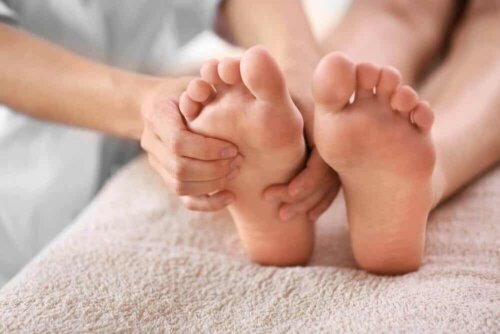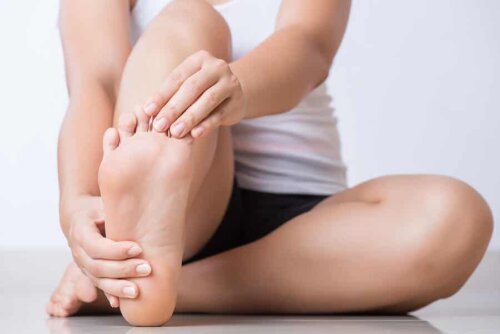Symptoms, Causes and Treatment of Hammertoes


Written and verified by the nurse Maria Marin Garcia
Hammertoes are a deformity that mainly affects this part of the feet, in which the toes acquire a flexed position that resembles a hammer, hence the name.
Between 2% and 20% of the population is either born with this condition or develops it during childhood. Hammertoes affect the joints of the foot bones, especially in the second, third, and fourth toes.
Occasionally, hammertoes can also occur in the fingers, but it’s usually due to traumatic causes. Continue reading to learn more about this body deformity.
What are hammertoes?
The main characteristic of this condition is an abnormal curvature as the toes bend in a Z-shape. They cause an extension of the metatarsal-phalangeal (MTP) joint and flexion of the distal interphalangeal joint — the one closest to the nail. There’s an alteration in the muscles, tendons, and ligaments that normally would keep the toes straight.
It’s sometimes painful and causes the formation of calluses and sores. Of course, these only worsen it. This happens because the curved area rubs against the footwear and leads to wounds. In addition, the people with this condition often have bunions too and these only further deformity and pain.

Do you ever wonder, Is Walking Barefoot Good or Bad for Children?
What causes this condition?
Hammertoes can be due to many reasons. As a general rule, the causes and risk factors for hammertoes are:
- Trauma due to falling and blows, fractures, compressions, and sprains in the phalanges can all cause injuries to ligaments, tendons, and muscles. These either don’t heal properly or are poorly positioned.
- Certain types of footwear don’t adapt well to the shape of the foot and so some of the toes receive too much extra weight and deform. High heels or extremely narrow shoes, for example.
- The bad posture of the foot.
- Diseases such as arthritis, poliomyelitis, and diabetes can increase the risk of developing foot deformities.
- Inherited congenital alterations affecting the anatomy can also alter the shape of the toes. An extra-long toe, for example.
- The older we get, the greater the risk of bone deformity due to fragility.
- Women are more prone to developing hammertoes.
Read about The Medical Treatment for Calluses on Hands and Feet
What are the symptoms of hammertoes?
In addition to the noticeable change in shape, or visible Z-shaped deformity, hammertoes usually have fairly common symptomatology in all people:
- Pain
- Inflammation or irritation caused by rubbing
- The presence of grazes or wounds due to the rubbing of the toes with the footwear
- Flushing or redness
- The appearance of corns or calluses
- Discomfort when wearing shoes
- Difficulty walking
- Finally, alterations of the balance in more serious cases

Treatment
One must take the flexibility of the limb into account when it comes to treatment as it varies according to the particular problem.
The solution is simple if the toe is still flexible. Physiotherapy is the main treatment in these cases, but always under professional supervision. For example:
- Walking correctly with wide and comfortable shoes
- Using cushioned insoles to distribute the weight throughout the sole of the foot
- Not wearing high heels
- Taping the toe to force it to be in a normal position
- Using splints and slings (this is similar to taping but more comfortable)
- Doing exercises to increase flexibility (traction of the toes, placing a towel rolled over the feet and crumpling it with the toes, lifting marbles with the toes, etc.)
Pain and inflammation require pharmacological treatment after medical evaluation.
A toe that’s no longer flexible will require surgical treatment to modify the joint and reconstruct it in a normal position. The surgery is a walk-in walk-out deal and doesn’t usually require hospitalization. Also, the recovery is relatively fast.
Mainly, the patient will have to wear special footwear for three weeks. Most people fully recover from this kind of surgery in about a month, if there are no complications. In fact, most can resume any of their physical activities by the second month.
Hammertoes, a common deformity
This is one of the most common toe deformities and several factors influence its appearance.
Finally, always consult your doctor if you have discomfort or pain in your feet. More specifically, consult a podiatrist (foot specialist). The earlier they detect an alteration, the better the prognosis.
All cited sources were thoroughly reviewed by our team to ensure their quality, reliability, currency, and validity. The bibliography of this article was considered reliable and of academic or scientific accuracy.
- Smit JM, Beets MR, Zeebregts CJ, Rood A, Welters CFM. Treatment options for mallet finger: A review. Vol. 126, Plastic and Reconstructive Surgery. 2010. p. 1624–9.
- Handoll HH, Vaghela M V. Interventions for treating mallet finger injuries. Cochrane Database Syst Rev. 2004 Jul 19;
- Piña-Oviedo S, Ro JY, Ayala AG, Park YK. Chondrosarcoma. In: Tumors and Tumor-Like Lesions of Bone: For Surgical Pathologists, Orthopedic Surgeons and Radiologists. Springer-Verlag London Ltd; 2015. p. 295–348.
- Ortesis para el tratamiento del dedo en martillo traumático: experiencia en la parroquia Guasdualito (Venezuela) [Internet]. [cited 2020 May 2]. Available from: http://scielo.sld.cu/scielo.php?script=sci_arttext&pid=S0864-215X2010000200007
This text is provided for informational purposes only and does not replace consultation with a professional. If in doubt, consult your specialist.








